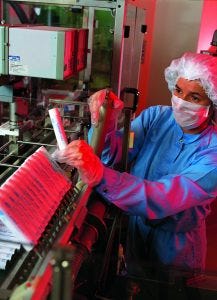October Spotlight
October 19, 2017
 Introducing New Editorial Advisor
Introducing New Editorial Advisor
Dr. Sanjay Nilapwar works as a purification process scientist in the novel-molecules group of Medimmune in Gaithersburg, MD, where he is also part of the platform chemistry, manufacturing, and controls (CMC) development team for antibody–drug conjugate products. In this position, he looks after the transitioning of ADC and monoclonal antibody (MAb) molecules as candidate drugs from development to the manufacturing stage, which encompasses cycles 1 and 2 purification process development, technology transfer and related CMC aspects including filing of investigational new drug (IND) applications.
In 2013, Nilapwar started working for Spirogen before its takeover by Medimmune. There, he worked on development of site-specific and stochastic conjugations based on pyrrolobenzodiazepines (PBDs) at research scale as well as on stability and analytical assay development. He was instrumental in setting up the medium-scale ADC purification laboratory at Medimmune. He first started working on protein conjugates at Piramal Lifescience by conjugating a range of therapeutics including cytotoxic molecules, radiolabeled chelates, and therapeutic MAbs for targeted therapies.
Nilapwar has over 12 years of experience in protein and conjugate purification development, on which he has published nine papers and written a couple of book chapters. He is a regular speaker at biopharmaceutical conferences and chairs conference sessions. After earning his master’s degree in pharmaceutical chemistry from Mumbai University in India on a research fellowship sponsored by the government of India, he went on to receive a PhD in molecular biology and biophysics from the University College London on an AstraZeneca sponsored scholarship. Nilapwar serves as a reviewer for half a dozen journals in addition to BPI and is on the editorial/review board of ADC Review, the British Journal of Pharmaceutical Research, and now BioProcess International.
A Dose of Reality — and Opportunity — for Drug Manufacturers
by Craig Hodgson (Loftware’s pharma-industry manager)
 At a recent pharmaceutical packaging and labeling event, a few startling statistics jumped out at me: 50% of pharmaceutical recalls are based on packaging and labeling errors; 60% of recalls are caused by human error; US$8 million is their average cost to companies. Those figures should keep drug companies on high alert as they look to implement best practices for their own packaging and labeling. They also should be ready for the FDA’s Drug Supply Chain Security Act (DSCSA), which starting in November 2017 will require that all products be clearly marked with a National Drug Code (NDC), serial number, lot number, and expiration date in both machine-readable and human-readable formats.
At a recent pharmaceutical packaging and labeling event, a few startling statistics jumped out at me: 50% of pharmaceutical recalls are based on packaging and labeling errors; 60% of recalls are caused by human error; US$8 million is their average cost to companies. Those figures should keep drug companies on high alert as they look to implement best practices for their own packaging and labeling. They also should be ready for the FDA’s Drug Supply Chain Security Act (DSCSA), which starting in November 2017 will require that all products be clearly marked with a National Drug Code (NDC), serial number, lot number, and expiration date in both machine-readable and human-readable formats.
It is expected that compliance with the DSCSA will reduce significantly the number of product recalls and associated costs. But compliance is not the only challenge for biomanufacturers. They must choose the best options that maintain or even improve supply chain efficiency. Here are a few ideas to keep in mind when evaluating your own labeling.
Take a programmatic, holistic approach. Break down organizational silos and get every department — from regulatory and package/label design to operations and logistics — into agreement. For many companies, it’s helpful to understand the “as-is” state before mapping out a new strategy. Collaboration is key for all stakeholders from the start even if getting there adds time and effort.
Optimize processes with integrated, automated technology. When you can integrate systems to share data, you improve consistency and accuracy to reduce duplication and the chance of errors. Automation brings much-needed speed to operations and can be accomplished by leveraging data from “sources of record.” Along with automating processes, make sure to standardize labeling systems to reduce complexity and incompatibility.
Think and act globally — not just complying with regional regulations, but also ensuring proper translation of packaging and labels to prevent delays and disruptions across the supply chain. When developing label content, make sure that all patients can understand it — something that not all biomanufacturers consider but that is critical to bridging the gap between US and international customers.
Be agile and ready for change. A labeling process needs built-in steps to evaluate performance and make adjustments as needed. Look for solutions that are configurable and that offer flexibility to keep up with constant change — whether driven by regulatory agencies or customers/providers. Applying business logic to automate formatting changes on labels, for example, can help prevent costly downtimes.
Many pharmaceutical companies are just getting by with their labeling but eager to find a better way to comply with regulations, improve operations, scale labeling across global enterprises, and avoid those scary statistics. Innovations in enterprise labeling can help you sustain compliance while providing a competitive edge.
Immunology, Oncology Markets Are Strong

The global immunology market covers autoimmune diseases such as rheumatoid arthritis, psoriasis, lupus, and ankylosing spondylitis. According to business intelligence provider GBI Research, the market capitalization is set to rise from $57.7 billion in 2015 to $75.4 billion by 2022 for a compound annual growth rate (CAGR) of almost 4%.
A 2017 GBI report, Global Immunology Drugs Market to 2022, identifies disease-modifying antirheumatic drugs (a highly genericized class of systematic small molecule-based agents) as first-line treatment for many immunological disorders. Such therapies often do not provide adequate long-term treatment, creating a large second-line therapy segment epitomized by the 1998 approvals of Janssen Biotech’s Remicade (infliximab) and Amgen’s Enbrel (etanercept), systemic monoclonal antibodies (MAbs) that have been commercially successful.
GBI analyst Qaisrah Khalid says that the many companies developing/marketing immunology products include top-20 big-pharmas such as AbbVie, Johnson & Johnson, Roche, Amgen, and Pfizer. “Although many approaching patent expiries — especially for Remicade and AbbVie’s Humira (adalimumab) — will affect these players directly, they are anticipated to maintain their high market shares in the area.”
In the large immunology pipeline, 2,054 products are in active development, nearly 100 of which are in phase 3. None of those late-stage products are expected to achieve the same levels of success as currently marketed MAbs. But GBI believes that a more competitive landscape will enable several candidates to generate strong annual revenues during the forecast period.
GBI Research also has analyzed the oncology market. Its report, Global Oncology Market to 2023: Robust Growth Driven by Rising Prevalence and Increased Uptake of Immune Checkpoint Inhibitors, finds that landscape to be highly competitive, with entrenched products competing for market share. Uptake of new products takes time: a ramp-up period of market share over 10 years in some cases. A continuing trend toward targeted patient subsets further constrains the available market share for new drugs. However, a number of late-stage pipeline candidates (e.g., the PD-1 inhibitor durvalumab and the CDK-4 and -6 inhibitor abemaciclib) should generate strong annual revenue during the forecast period.
Chimeric antigen receptor (CAR) T-cell therapies such as Novartis’s tisagenlecleucel-T and Kite Pharma’s KTE-C19 also are expected to achieve blockbuster revenues during this period. GBI says that an exceptionally large overall pipeline (7,701 products in development) indicates continued long-term growth in this market.
Managing analyst Dominic Trewartha says, “The key market players — namely Roche, Celgene, Bristol-Myers Squibb and Novartis — are forecast to achieve strong revenue growth throughout the market period.” With entry and growth of new players such as AstraZeneca, Pfizer, and Merck, the oncology market shares of those key players all are anticipated to decrease substantially by 2023. Despite the approaching patent expiries of Avastin (nivolumab), Kadcycla (ado-trastuzumab emtansine), Perjeta (pertuzumab), and Tarceva (pembrolizumab), Roche should maintain the highest market share of any company, accounting for 25% of revenues in the oncology innovator market by 2023 — but that will be down from 45% in 2016.
GBI says that a product entering clinical development has a 72% likelihood of failing to reach the market. It is widely understood that the cost of bringing drugs to market is increasing. Dominic Trewartha explains: “The growth in drug development costs has been attributed to higher failure rates for drugs tested in clinical trials.” A range of factors are thought to have made clinical trials more expensive: more complex studies, larger average trial sizes, higher costs of inputs from the medical sector, and increased targeting of chronic and degenerative diseases. “First-in-class innovation is a key strategy,” Trewartha continues. He says that both the yearly number of new chemical entity FDA approvals and the number of first-in-class products have increased in recent decades. “Indeed, the proportion of first-in-class approvals has increased steadily each year since 1994.”
Dermatology: Opportunities in Innovative Development and Market Access Strategy
 Covering more than 3,000 distinct conditions ranging from rare autoimmune disorders such as scleroderma to common conditions such as acne, the global dermatology market is set for an increased presence of biologics over the next few years. Business intelligence provider GBI Research points out monoclonal antibodies (MAbs) and biosimilars in particular in its recent report, Frontier Pharma: Dermatology — Intracellular Signal Transducers and Cytokine Signaling Molecules Dominate Pipeline and First-in-Class Innovation. For the past decade, most of the therapeutic dermatology market has been saturated and highly genericized. But the report identifies a significant unmet need for more efficacious and safer treatment options because long-term use of many available treatments is associated with poor efficacy, low patient compliance, and problematic safety profiles.
Covering more than 3,000 distinct conditions ranging from rare autoimmune disorders such as scleroderma to common conditions such as acne, the global dermatology market is set for an increased presence of biologics over the next few years. Business intelligence provider GBI Research points out monoclonal antibodies (MAbs) and biosimilars in particular in its recent report, Frontier Pharma: Dermatology — Intracellular Signal Transducers and Cytokine Signaling Molecules Dominate Pipeline and First-in-Class Innovation. For the past decade, most of the therapeutic dermatology market has been saturated and highly genericized. But the report identifies a significant unmet need for more efficacious and safer treatment options because long-term use of many available treatments is associated with poor efficacy, low patient compliance, and problematic safety profiles.
GBI associate analyst Jennifer Goossens explains: “By contrast with the market, the dermatology pipeline is highly diverse in terms of molecule type.” Small molecules continue to dominate over half of the pipeline, whereas biomolecules represent over a third, and ~10% are rarer types of treatments such as cell and gene therapies and synthetic peptides. Whereas MAbs have begun to establish a market presence, other biologics are not yet well established in this market. “A particularly high degree of diversity is seen at the discovery and preclinical stages,” Goossens says, “where MAbs, proteins, oligonucleotides, and synthetic peptides account for a considerable proportion of the pipeline.”
Improved understanding of the inflammatory and systemic nature of many skin diseases has led to development of biologics that target specific proinflammatory cytokines or other relevant mediators involved in dermatological disorders. The use of biologics in dermatology has gained prominence over the years, primarily for psoriatic disease, clinical success with which has created enthusiasm for their application to other dermatological conditions. Goossens says that is evidenced by biologics in development for major skin disorders with significant unmet need in patients with moderate to severe conditions.
Since 2014, five potential blockbuster drugs have been approved as dermatology therapies, with GBI forecasting them to achieve an aggregate annual revenue of $12.4 billion by 2023. Four of those five market-driving drugs — Novartis’s Cosentyx (secukinumab), Celgene’s Otezla (apremilast), Pfizer’s Eucrisa (crisaborole), and Eli Lilly’s Taltz (ixekizumab) — were approved for psoriasis. The fifth, Sanofi/Regeneron‘s Dupixent (dupilumab), became the first and only biologic to be approved for treatment of atopic dermatitis. Indeed, the latter is expected to face very little competition and as a result will generate the second highest revenue of any drug in that therapeutic area.
GBI associate analyst Ross Wilkinson says that the dermatology space contains 850 pipeline products with a disclosed stage of development, but that most are in early stages. Biosimilars make up just 6% of this pipeline but account for 24% of the later phases of clinical development. “Biosimilar manufacturers are attracted to the dermatology therapy area following the patent expiration of a number of commercially successful products.” AbbVie’s risankizumab and Johnson & Johnson’s guselkumab should be approved by 2023, “but both will fail to achieve the same level of commercial success as early market entrants because the psoriasis market now contains a number of branded biologics and will become further saturated as new biosimilars enter. However, the pipeline is promising for smaller indications such as acne vulgaris and epidermolysis bullosa, which both could see approval of new first-in-class products.”
According to market analysis firm GlobalData, the dermatology therapy area is dominated by big-pharma companies. In 2016 the most commercially successful players in this sector were Johnson & Johnson, AbbVie, Amgen, Novartis and Pfizer. Across the forecast period, these companies will continue to generate high revenue.
Specialization and treatment of unmet need are the new buzzwords in dermatology research, with companies finding greatest success by focusing on specific therapeutic areas and developing novel treatments for niche diseases. The market landscape has become, according to GlobalData, “broader, deeper, and far more intricate in recent years,” a trend that is likely to continue.
Regulatory authorities are adapting to the needs of both drug developers and patients, providing alternative pathways to approval and thus influencing market access strategies. Review designations such as FDA Breakthrough Therapy in the United States, EMA PRIME in Europe, and PMDA Sakigake in Japan are being awarded with greater frequency and are contributing to a dermatology pipeline focused on the treatment of unmet needs.
GlobalData’s senior healthcare analyst Jamie Goodman says, “Companies are recognizing that innovation is more necessary than ever in ensuring return on investment. Niche drug development and perusal of alternative pathways and regulatory designations have proved to be popular strategies.” More than 2,100 therapeutics have been awarded a review designation by the US FDA overall, and more than 2,000 unique indications have at least one drug in development.
Research Agreement for Intracellular Biologics
In May, Elasmogen Ltd. (a biopharmaceutical company with ties to the University of Aberdeen in Scotland) and Feldan Therapeutics (a Canadian company focused on intracellular delivery of proteins) announced a research collaboration with Amgen to develop and deliver novel intracellular biologics. This collaboration combines the Feldan’s Shuttle platform and Elasmogen’s soloMER technology to develop a delivery system and binding domains to two undisclosed intracellular targets for Amgen. It builds on a 2016 partnership between Feldan and Elasmogen. Working together, their research teams have demonstrated both intracellular and intranuclear delivery of soloMER binding domains.
Feldan’s peptide-based Shuttle delivery technology enables highly efficient introduction of foreign proteins into cells. Elasmogen’s proprietary molecules are the smallest naturally occurring binding domains. Their robust nature (particularly resistance to changes in pH and an ability to bind in intracellular conditions) complements the Feldan method.
“Currently all approved biologic antibody therapeutics act on extracellular targets,” said François-Thomas Michaud (Feldan Therapeutics CEO), “but intracellular delivery enables access to a much greater number of targets. Intracellular delivery and binding can bridge the gap between small molecules and biologics.”
“This is an exciting opportunity to demonstrate the performance and capabilities of the combined Shuttle–soloMER technology,” said Caroline Barelle (Elasmogen CEO). “The expertise provided by Amgen will significantly accelerate the development of this potential new class of therapeutics.”
Supplier/Provider Merger Trend Continues
In May, Thermo Fisher Scientific, Inc. and Patheon entered into a definitive agreement for the instrument/consumables supplier to acquire the contract development and manufacturing organization (CDMO) in a transaction expected to be complete by the end of 2017. Patheon will continue to deliver its full spectrum services with no changes expected to existing contracts. The combined company will enjoy an expanded and improved ability to serve clients and customers without disruption in points of contact, workflow, and deliveries.
This is part of a trend identified by market research company ISR, whose directors have analyzed the pharmaceutical outsourcing industry for over 20 years. The trend for many drug companies over the past 5–10 years has been to develop strategic partnerships with service providers to drive down costs and improve operational integration. Service providers have increased their share of pharmaceutical spending to the point at which some services are almost completely outsourced to third-party providers. What was once an industry whose growth was driven primarily by organic efforts and minor/bolt-on acquisitions now is characterized by large mergers and acquisitions: e.g., Lonza–Capsugel, LabCorp–Covance, Quintiles–IMS, and INC Research–inVentive Clinical.
Service providers are ever aware that mergers between pharmaceutical companies can have a material impact on their business. Terms such as “vendor consolidation” and “R&D pipeline synergies” can wreak havoc on a service provider after a client merger. At ISR, the research team is wondering whether the industry may be nearing a tipping point at which service-provider mergers dramatically affect the business of drug companies as well. Regardless of the players involved, the ISR team says that mergers are always disruptive.
Molecular Evidence Development Consortium (MED-C) Becomes Cure-One
 The nonprofit Molecular Evidence Development Consortium (MED-C), an organization devoted to advancing precision medicine, has changed its corporate name to Cure-One. “The MED-C name described our intentions — bringing people together to collect better evidence to support precision medicine,” explained founder and CEO Dane J. Dickson, MD. “As we have evolved, it’s now time for us to focus on the ultimate goal”: collecting data in an effort to cure diseases for which there are none currently. “The goal is to cure people one by one.”
The nonprofit Molecular Evidence Development Consortium (MED-C), an organization devoted to advancing precision medicine, has changed its corporate name to Cure-One. “The MED-C name described our intentions — bringing people together to collect better evidence to support precision medicine,” explained founder and CEO Dane J. Dickson, MD. “As we have evolved, it’s now time for us to focus on the ultimate goal”: collecting data in an effort to cure diseases for which there are none currently. “The goal is to cure people one by one.”
Cure-One has created its N1 Registry to “connect the dots between high quality, standardized molecular testing and associated clinical outcomes for cancer patients.” The database will provide direct access to richly detailed genetic-level testing and help researchers tie that information to associated clinical outcomes. The registry is built to motivate patients, mediate among providers, and deliver more unified healthcare, ultimately closing disconnects and catalyzing precision medicine to deliver personalized cures.
“We want to build a sustainable database,” Dickson said, “one that is standardized and accessible for everyone so that all will benefit: Insurers will receive critical information regarding quality, patients will have access to better diagnostics and more effective treatments, and physicians will be able to provide better options for their patients. Pharmaceutical companies, researchers, and laboratories will benefit from the rapid advancement of precision medicine.”
Through the registry, Cure-One wants to help patients get high-quality genomic testing and improve researchers’ understanding of the genetic basis of malignancy as it relates to physician decisions and patient outcomes. The organization will work with top laboratories performing next-generation sequencing (NGS) in both solid-tissue and liquid biopsies to established high-quality standards. It will collect genomic data to facilitate a comprehensive understanding of the complexity, intricacy, and application of NGS testing. And it can act as a conduit for enrollment in clinical trials, supporting advancements in precision medicine by collecting clinical outcomes data associated with molecular or immunologic testing and treatments. Cure-One also will collect information on the increasing number of patients who have received or will receive NGS testing and align itself with the direction and efforts of other national and international groups seeking to advance precision medicine.
This past summer the group identified Foundation Medicine (Cambridge, MA) and Guardant Health (Redwood City, CA) as cornerstone laboratories in its N1 Registry. The former develops and manufactures genomic analysis diagnostics for cancers; the latter focuses on blood-based assays, large data sets, and advanced analytics.
“Our collaboration with Cure-One is consistent with Foundation Medicine’s approach to data sharing and data transparency,” said Troy Cox, Chief Executive Officer for Foundation Medicine, “and reinforces our vision that progress in personalized cancer care can best be accelerated through a collaborative exchange of molecular information.” This data collaboration should serve as an example in the oncology community for the benefits of public–private partnerships in data exchange.
“Guardant Health’s participation with our N1 Registry is a testament to its commitment to advance the field of precision medicine and to increase the availability of noninvasive comprehensive sequencing to advanced cancer patients,” added Dickson. For more information, please visit www.cure-one.org.
Supplier Commits to Sustainability
BioTek Instruments opened its second solar facility in May 2017 (the first being a 500-kW solar farm in Whiting, VT). This new 88-kW photovoltaic solar energy farm is now on line in Milton, VT, and was developed with the help of ABJ Property Management and installed by Norris Brothers Solar Development.
The additional renewable energy will provide power to a 22,000-ft2 facility expansion and offset 100% of the company’s annual electricity costs. BioTek vice president Adam Alpert called it “a continuation of our existing company-wide programs promoting energy conservation, recycling, and environmental protection. This new initiative is a testament to our passion and commitment towards clean energy and a greener tomorrow.”
BioTek has joined more than 1,200 governors, mayors, businesses, investors, and colleges and universities across the United States who voiced their intent to ensure that the country remains a global leader in reducing carbon emissions. By declaring, “We are still in,” the signatories to a recent statement say they are putting the best interests of their constituents, customers, students, and communities first while assuring the rest of the world that American leadership on climate change extends well beyond the current federal government.
The science is clear: The planet’s climate is changing, largely because of human activity, and the effects on global life will be negative. The only question is the magnitude of that impact. Alpert said, “BioTek is committed to decreasing its carbon footprint by focusing both on energy efficiency and renewable sources for power. Locally and in partnership with the many governments, companies, and institutions dedicated to reducing carbon emissions, we are taking steps that will help achieve the bigger goal — a cleaner and safer environment around the world.”
Headquartered in Winooski, VT, BioTek Instruments designs, manufactures, and distributes life-science instruments that enable research by providing high-performance, cost-effective analysis and quantification of biomolecules, biomolecular interactions, and cellular structure and function across diverse applications.
You May Also Like





